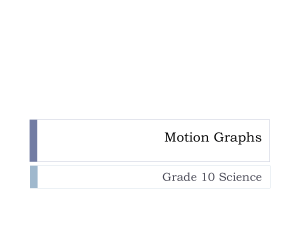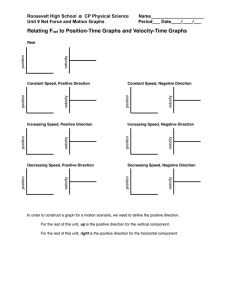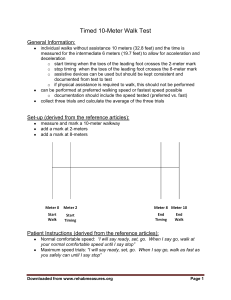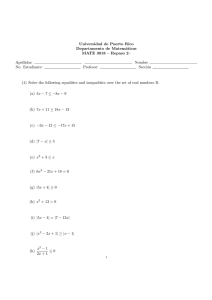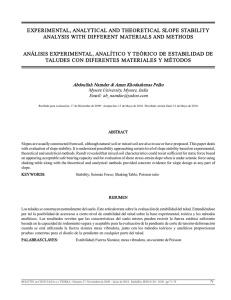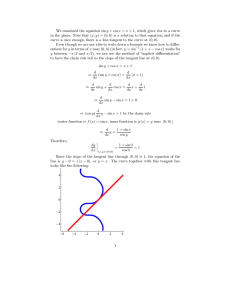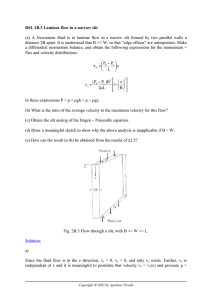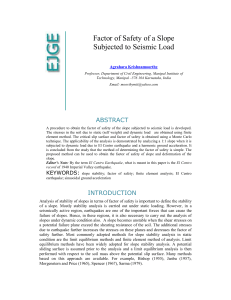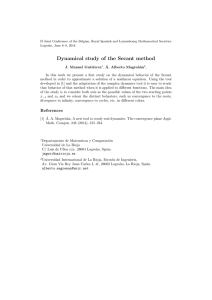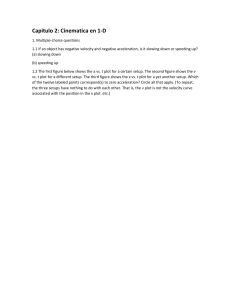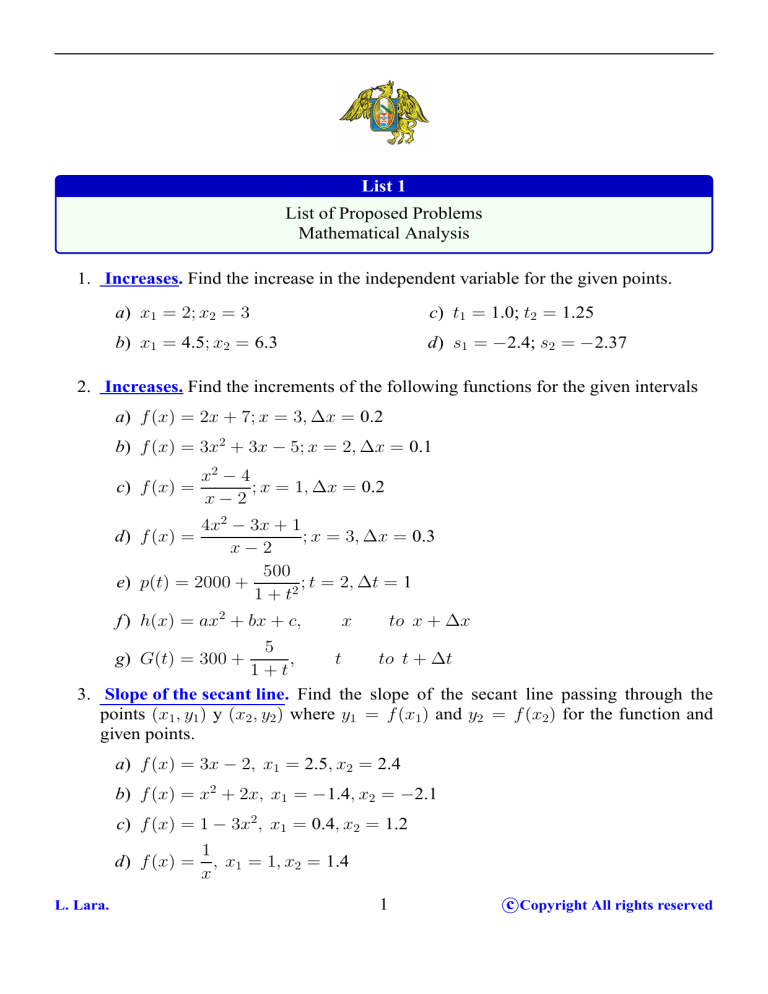
List 1 List of Proposed Problems Mathematical Analysis 1. Increases. Find the increase in the independent variable for the given points. a) x1 = 2; x2 = 3 c) t1 = 1.0; t2 = 1.25 b) x1 = 4.5; x2 = 6.3 d) s1 = −2.4; s2 = −2.37 2. Increases. Find the increments of the following functions for the given intervals a) f (x) = 2x + 7; x = 3, ∆x = 0.2 b) f (x) = 3x2 + 3x − 5; x = 2, ∆x = 0.1 x2 − 4 c) f (x) = ; x = 1, ∆x = 0.2 x−2 4x2 − 3x + 1 ; x = 3, ∆x = 0.3 x−2 500 e) p(t) = 2000 + ; t = 2, ∆t = 1 1 + t2 d) f (x) = f ) h(x) = ax2 + bx + c, x to x + ∆x 5 , t to t + ∆t 1+t 3. Slope of the secant line. Find the slope of the secant line passing through the points (x1, y1) y (x2, y2) where y1 = f (x1) and y2 = f (x2) for the function and given points. g) G(t) = 300 + a) f (x) = 3x − 2, x1 = 2.5, x2 = 2.4 b) f (x) = x2 + 2x, x1 = −1.4, x2 = −2.1 c) f (x) = 1 − 3x2, x1 = 0.4, x2 = 1.2 1 d) f (x) = , x1 = 1, x2 = 1.4 x L. Lara. 1 c Copyright All rights reserved 4. Average speed. Find the average velocity for the position function h(t) = −4.9t2 + 50t + 40, meters in the given time intervals. a) t1 = 1 to t2 = 1.5 s. b) t1 = 1 to t2 = 1.1 s. c) t1 = 1 to t2 = 1.01 s. d) t1 = 1 to t2 = 1.001 s. e) t1 = 1 a t2 = 1 + h seconds, where h is the increment of time. f ) what happens if we make h → 0 (the result obtained is the instant speed flame in t = 1 seconds) 5. Average exchange rate. Find the average exchange rate of each function in the given interval. a) f (x) = x2 − 2x + 3; x1 = 2, x2 = 2.5 x b) f (x) = ; x1 = 1.1, x2 = 1.4 1 + x2 6. Concept questions refer to the following figure. Let P (2, f (2)) and Q(2+h, f (2+ h)) be points on the graph of a function f . a) Find an expression for the slope of the secant line passing through P and Q. b) Find an expression for the slope of the tangent line passing trough P . 7. Interpretation. (a) Give a geometric and a physical interpretation of the expression L. Lara. 2 c Copyright All rights reserved f (x + h) − f (x) h (b) Give a geometric and a physical interpretation of the expression f (x + h) − f (x) h→0 h lı́m 8. Slope. Let f (x) = x2 a) Compute the slope of the secant line joining the points on the graph of f whose x coordinates are x = −2 and x = −1.9 b) Use calculus to compute the slope of the line that is tangent to the graph of f when x = −2 and compare with the slope found in part (a) x 9. Slope. Let f (x) = x−1 a) Compute the slope of the secant line joining the points on the graph of f whose x coordinates are x = −1 and x = −0.5 b) Use calculus to compute the slope of the line that is tangent to the graph of f when x = −1 and compare with the slope found in part (a) 10. Derivative. Find the derivative of the given function using the following limit ′ f (x + h) − f (x) h→0 h f (x) = lı́m if the limit exists, for a) f (x) = x2 b) f (x) = x2 − 3x c) f (x) = 4x − 3 d) f (x) = 1 − x2 2 e) f (x) = x+1 x f ) f (x) = x−1 2x + 3 g) f (x) = x+4 h) f (x) = √ 2x + 1 i) f (x) = sin x j) f (x) = cos x 11. Derivative. Find the derivative of the given function using the following limit L. Lara. 3 c Copyright All rights reserved f (x) − f (x0) 0 x − x0 ′ f (x0) = x→x lı́m if the limit exists, for d) f (x) = x2 − 3x − 1, x0 = −1 √ e) f (x) = x, x0 = 4 a) f (x) = 10x2 − 3, x0 = 1 b) f (x) = x3 − 4x2, x0 = −1 c) f (x) = 4 , x0 = 2 3−x 12. Slope. Find the slope of the function’s graph at the given point. Then find an equation for the line tangent to the graph there. √ d) f (x) = x + 1, (8, 3) a) f (x) = x2 + 1, (2, 5) x x−1 b) f (x) = , (3, 3) e) f (x) = , (0, −1) x−2 x+1 8 c) f (x) = 2 , (2, 2) x 13. Slope and tangent line. Let f (x) = ′ a) Find the derivative f of f 1 x−1 b) Find an equation of the tangent line to the curve at the point (−1, − 12 ) c) Sketch the graph of f and the tangent line to the curve at (−1, − 12 ) 14. Average rate. Let y = x2 + x a) Find the average rate of change of y with respect to x in the interval from x = 2 to x = 3, from x = 2 to x = 2.5, and from x = 2 to x = 2.1 b) Find the instantaneous rate of change of y at x = 2 c) Compare the results obtained in part (a) with that of part (b) 15. Velocity of a car. Suppose the distance s (in feet) covered by a car moving along a straight road after t sec is given by the function s = 2t2 + 48t a) Calculate the average velocity of the car over the time intervals [20, 21], [20, 20.1] and [20, 20.01] b) Calculate the instantaneous velocity of the car when t = 20 L. Lara. 4 c Copyright All rights reserved c) Compare the results of part (a) with the part (b) 16. Velocity of a ball thrown into the air. A ball is thrown straight up with an initial velocity of 128 f t/sec, so that its height (in feet) after t sec is given by s(t) = 128t − 16t2. a) What is the average velocity of the ball over the time intervals [2, 3], [2, 2.5], and [2, 2.1] ? b) What is the instantaneous velocity at time t = 2 ? c) What is the instantaneous velocity at time t = 5 ?. Is the ball rising of falling at this time? d) When will the ball hit the ground? 17. Hot-air balloon rises. A hot-air balloon rises vertically from the ground so that its 1 1 height after t sec is h = t2 + t f t 0 ≤ t ≤ 60. 2 2 a) What is the height of the balloon at the end of 40 sec ? b) What is the average velocity of the balloon between t = 0 and t = 40 ? c) What is the velocity of the balloon a the end of 40 sec? 18. Temperature. At a temperature of 20oC, the volume V (in liters) of 1.33 g of O2 is 1 related to its pressure p (in atmospheres) by the formula V = p a) What is the average rate of change of V with respect to p as p increases from p = 2 to p = 3? b) What is the rate of change of V with respect to p when p = 2? 19. Tangent lines with specified slopes. a) At what points do the graphs of the functions have horizontal tangents? (a) f (x) = x2 + 4x − 1 and (b) g(x) = x3 − 3x b) Find equations of all lines having slope −1 that are tangent to the curve 1 y= x−1 c) Find an equation of the straight line having slope 1/4 that is tangent to the √ curve y = x 20. Vertical tangents. Graph the curves in the exercises (a) Where do the graphs appear to have vertical tangents ?. (b) Confirm your findings in part (a) with limit L. Lara. 5 c Copyright All rights reserved calculations. L. Lara. a) y = x2/5 d) y = x3/5 g) y = x2/3 − (x − 1)1/3 b) y = x4/5 e) y = 4x2/5 − 2x h) y = x1/3 + (x − 1)1/3 c) y = x1/5 f ) y = x5/3 − 5x2/3 i) y = |4 − x| 6 q c Copyright All rights reserved
